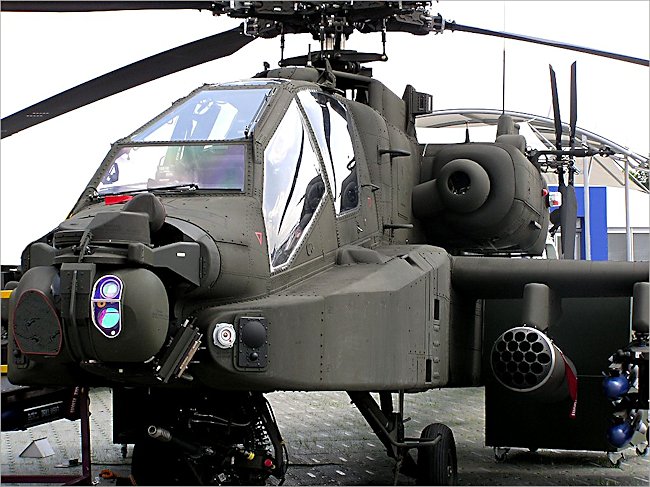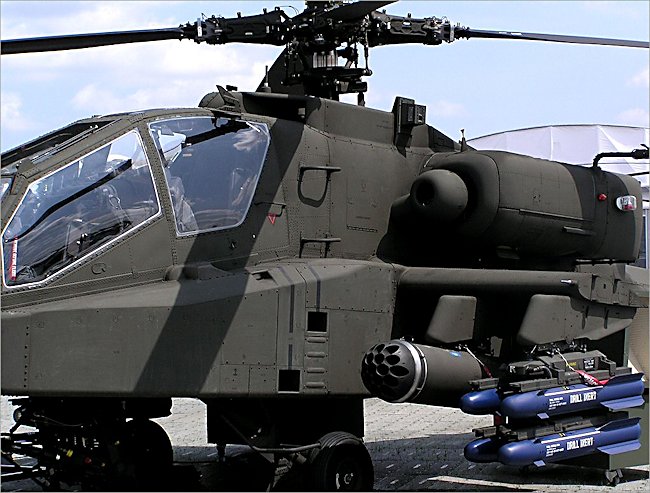AH-64 Apache Longbow Helicopter
The AH-64 Apache, the world's premier four-blade, twin-engine attack helicopter was designed to be an extremely tough survivor under combat. Hughes Helicopter Inc won the prestigious Collier trophy for the design of the AH-64 Apache. The prototype Apache was developed during the Cold War and made its first flight in 1975. It was intended to give close support to infantry units fighting off a soviet armoured invasion of north west Europe.
In 1983 Hughes Helicopter Inc was purchased by McDonnell Douglas Helicopter Systems. The United States Army received their first operational AH-64 Apache attack helicopters in January 1984. The helicopter section of the company later became part of the Boeing Company with the merger of Boeing and McDonnell Douglas in August 1997.

US Military McDonnell Douglas Boeing AH-64 Apache Longbow Attack Helicopter is a highly manoeuvrable, heavily armed ground-support attack helicopter. It has a target acquisition and designation system (TADS) and a pilot's night vision sensor (PNVS) to enable it to perform in most weathers and around the clock. The Apache crew sits in tandem, with the pilot sitting behind and above the copilot/gunner. The crew compartment and fuel tanks are armored such that the aircraft will remain flyable even after sustaining hits from 23-millimeter.
The AH-64 Apache uses the same T700 engines as other US Military helicopters like the Sikorsky UH-60 Black Hawk utility helicopter to make maintenance and logistics less complicated. It can rapidly detect, classify, prioritise and engage stationary or moving enemy targets at standoff ranges in nearly all weather conditions using its Longbow's fire-control radar advanced avionics suite and Hellfire missiles.

It can attack tanks, armoured vehicles, and troops with rockets, missiles and 30mm cannon. It was designed to stop the tanks of the Soviet Eastern Block during the Cold War but has seen active service in the jungles of Central America, the deserts of the Middle East and the Kosovo conflict.
The AH64 Apache Longbow is armed with a 30-millimeter (1.2 in) M230 Chain Gun carried between the main landing gear, under the aircraft's forward fuselage. It has four hardpoints mounted on stub-wing pylons, which can carry a mixture of AGM-114 Hellfire and Hydra 70 rocket pods..
You will notice above the rotor blades a round disk that houses a bunch of avionics. This clever piece of kit allows the AH-64 Apache Longbow Attack Helicopter to hid behind hard and soft cover whilst looking out for enemy movement and future targets. When it finds a prey it just has to lock on with, zoom up, fire and then descend back under cover.
The United States Army used the AH-64 Apache during Operation Just Cause, the invasion of Panama in 1989.
AH-64 Apache Longbows were used continually during the invasion of Iraq as part of Operation Iraqi Freedom in 2003. One was shoot down and about 30 were damaged. In 1990 Apaches were used in a "peace keeping" role in Kosovo and Bosnia.
During the first attacks of Operation Desert Storm in January 1991 Apache attack helicopters were again at the front. They went on to be credited with over 500 tank kills with only the loss of one helicopter to an RPG hit at close range. The armour in the cockpit helped protect the two man crew who both survived the crash.
Operation Enduring Freedom in Afghanistan that started in 2001 has involved the deployment of Apache helicopters in ground support missions as well as casualty evacuation escort roles.
The British army purchased Apache longbow attack helicopters for ground support roles and for operations based on Royal Navy warships and fleet auxiliaries. As such they specified some modifications to the Apaches used by the US Army. The rotary blades on the British Apaches fold to allow for transportation on navy ships. UK Apache helicopters are designated AH1 and are fitted with more powerful Rolls-Royce engines. They were regularly deployed in Iraq and Afghanistan. The above photograph is of a British Apache attack helicopter. You can tell by the Radar and Missile Warning sensors on the nose. Those DAS sensors are unique to the UK.